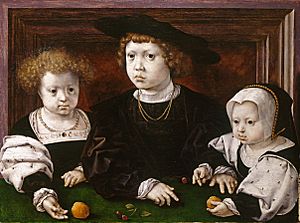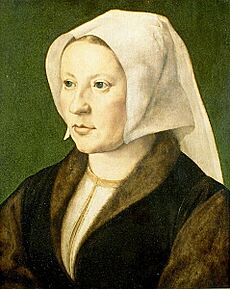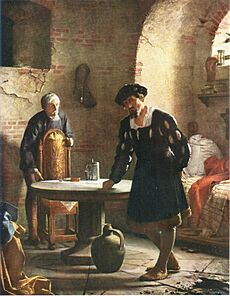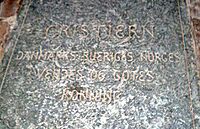Christian II of Denmark facts for kids
Quick facts for kids Christian II |
|
|---|---|

Portrait by Lucas Cranach the Elder, c. 1523
|
|
| King of Denmark and Norway (more...) | |
| Reign | 22 July 1513 – 20 January 1523 |
| Coronation | 11 June 1514, Copenhagen 23 July 1514, Oslo |
| Predecessor | John |
| Successor | Frederick I |
| Viceroy of Norway | |
| Reign | 1506 - 20 January 1513 |
| Predecessor | John |
| Successor | Christian II (As king) |
| King of Sweden (more...) | |
| Reign | 1 November 1520 – 23 August 1521 |
| Coronation | 4 November 1520 Storkyrkan, Stockholm |
| Predecessor | John II |
| Successor | Gustav I |
| Born | 1 July 1481 Nyborg Castle |
| Died | 25 January 1559 (aged 77) Kalundborg Castle (as prisoner) |
| Burial | St. Peter's Abbey, Ghent (1559–1883) St. Canute's Cathedral, Odense (since 1883) |
| Spouse | |
| Issue among others... |
John Dorothea, Electress Palatine Christina, Duchess of Milan |
| House | Oldenburg |
| Father | John, King of Denmark |
| Mother | Christina of Saxony |
| Signature | |
Christian II (born 1 July 1481 – died 25 January 1559) was a king who ruled over several Scandinavian countries. He was King of Denmark and Norway from 1513 to 1523. He also ruled Sweden from 1520 to 1521. These countries were part of the Kalmar Union, a union of Nordic kingdoms. From 1513 to 1523, he was also a Duke of Schleswig and Holstein alongside his uncle, Frederick.
As king, Christian II wanted to keep the Kalmar Union strong. This led to a long war with Sweden between 1518 and 1523. He managed to conquer Sweden in 1520. However, he then ordered the execution of many important Swedish people. This event is known as the Stockholm Bloodbath. It caused the Swedes to rebel against him. A Swedish nobleman named Gustav Vasa led this rebellion. Christian II was removed from power in Sweden.
In Denmark, Christian II tried to make big changes to the government. He wanted to give more rights to ordinary people. This would have reduced the power of nobles and church leaders. But the nobility rose up against him in 1523. He was forced to leave Denmark and went to the Netherlands. His uncle Frederick then became King of Denmark. In 1531, Christian II tried to get his thrones back. But he was captured and held prisoner for the rest of his life. He died in 1559 at Kalundborg Castle.
Christian II married Isabella of Austria in 1515. She was the granddaughter of a powerful emperor. Isabella died in 1526. Her family then took Christian's three children away. Christian also had a close advisor named Sigbrit Willoms. She was the mother of Dyveke Sigbritsdatter, who died in 1517. Christian believed Dyveke was poisoned. His actions against the person he thought was responsible made many nobles turn against him.
Contents
Early Life and Rise to Power
Christian II was born at Nyborg Castle in 1481. His father was John, King of Denmark, and his mother was Christina of Saxony. Christian came from a long line of kings. He was related to earlier Swedish kings through his family.
As a young man, Christian helped his father in wars. He was part of the conquest of Sweden in 1497. He also fought in the Dano-Swedish War (1501–1512). In 1506, he was made the viceroy of Norway. This meant he was the king's representative there. He successfully kept control of Norway. During his time in Norway, he tried to reduce the power of the Norwegian nobles. They usually had a lot of influence through their council, called the Rigsraadet. This caused some arguments with the nobles.
In 1513, Christian became King of Denmark and Norway after his father died. Important leaders from Denmark, Norway, and Sweden met in Copenhagen. They confirmed Christian's rule in Denmark and Norway. The Swedish leaders, however, delayed their decision about who would be their king. Christian was crowned King of Denmark in Copenhagen and King of Norway in Oslo in the summer of 1514.
Family and Advisors
Christian II married Isabella of Austria in 1515. She was the granddaughter of Maximilian I, Holy Roman Emperor, a very powerful ruler. Their marriage was first agreed upon in Brussels. Isabella came to Copenhagen a year later. The official wedding took place at Copenhagen Castle in August 1515.
In 1517, a woman named Dyveke died. Christian believed she had been poisoned by a nobleman named Torben Oxe. Usually, a nobleman like Oxe would be tried by the highest council of the state. But Christian had him tried by a common jury instead. Oxe was found guilty and executed in November 1517. This event caused a big split between the king and the powerful noble families. This disagreement eventually led to Christian losing his throne.
Christian's main advisor was Sigbrit Willoms, Dyveke's mother. Christian gave her important roles, like managing taxes on ships passing through the Øresund strait. He also listened to her advice on money matters. Sigbrit came from a middle-class background. She worked to increase the power of the middle class. She even formed a special council that competed with the traditional noble council. The nobles did not like her influence. They blamed her for the king's support of ordinary working people.
Conquering Sweden
Christian II was preparing for war with Sweden. In Sweden, there were two main groups. One group, led by Sten Sture the Younger, was against Danish rule. The other group, led by Archbishop Gustav Trolle, supported Denmark.
In 1517, Christian sent soldiers to help Archbishop Trolle. But Sten Sture and his peasant army defeated Christian's forces. A second attempt in 1518 also failed. Sten Sture won another battle.
Christian tried a third time in 1520. This time, he had a large army of soldiers from France, Germany, and Scotland. This attempt was successful. Sten Sture was badly wounded in a battle in January. The remaining Swedish rebels were defeated in April. Stockholm, the capital, held out until September 1520. Christian was crowned King of Sweden in November. The Swedish council agreed, but only if Christian promised to rule Sweden fairly.
The Stockholm Bloodbath
Just three days after Christian's coronation, Archbishop Trolle accused Sten Sture's supporters of being rebels. He claimed they had committed treason by rising against him. Christian used this as a chance to get rid of his opponents in Sweden. He set up a special court. This court found many people guilty.
On November 8 and 9, eighty-two Swedish noblemen were executed in Stockholm. This included two bishops. Christian also executed some people who had supported the Kalmar Union. He even had the bodies of Sten Sture and his child dug up and burned. Sten Sture's widow, Christina Gyllenstierna, and other noble Swedish women were sent to Denmark as prisoners.
Instead of making Christian's rule stronger, the Stockholm Bloodbath had the opposite effect. It led to Sweden breaking away from the Kalmar Union. The new ruler Christian appointed in Sweden was cruel. The remaining Swedish nobles were horrified by the executions. They rebelled against Christian. The Swedish assembly chose Gustav Vasa as their new leader and later as King of Sweden. Because of this massacre, Christian is known in Sweden as Christian the Tyrant.
New Laws and Downfall
In June 1521, Christian II visited Charles V, Holy Roman Emperor in the Netherlands. He stayed there for several months. He met famous artists like Albrecht Dürer and thinkers like Erasmus. He discussed new ideas, including the Protestant Reformation.
When he returned to Denmark in September 1521, Christian made two important new laws. These were the Town Law and the Land Law. The Town Law gave more rights to merchants and peasants. It made trade happen only in market towns. These towns were controlled by officials chosen by the king. It also made it illegal to trade peasants. Peasants were given the right to discuss their living conditions with nobles. The Land Law allowed church leaders to marry. It also gave the state more control over the church. These new laws were very modern. But the nobles and bishops saw them as a big threat to their power.
By 1522, Christian II had few friends left. He tried to create a Danish trading company to compete with the powerful Hanseatic League. He also raised taxes on ships passing through the Øresund strait. This affected trade between Sweden and the Hanseatic cities. As a result, the cities of Lübeck and Danzig joined the newly independent Sweden in a war against Denmark.
Rebellion against Christian started in Jutland, a part of Denmark. On January 20, 1523, a meeting of important Danish leaders offered the Danish crown to Christian's uncle, Duke Frederick of Holstein. Frederick's army quickly took control of most of Denmark. In April 1523, Christian left Denmark to find help from other countries.
Exile and Imprisonment
In exile, Christian lived a quiet life in the Netherlands. He hoped for military help from his brother-in-law, Charles V. For a while, Christian became a follower of Martin Luther and the Protestant faith. He even ordered a translation of the New Testament into Danish.
His wife, Isabella, died in January 1526. Her family then took Christian's children. They did not want them to be raised as Protestants. In Denmark, some people still supported Christian. A man named Søren Norby gathered an army of peasants. But they were defeated in 1525.
By 1531, Christian had returned to the Catholic faith. He made peace with the Emperor. He sailed with a fleet to Norway. He landed in Oslo in November 1531 and was welcomed by many people. However, Christian could not capture Akershus Castle. He accepted a promise of safe passage from Frederick I in 1532.
But Frederick did not keep his promise. Christian was held prisoner for the next 27 years. He was first held at Sønderborg Castle until 1549. After that, he was moved to Kalundborg Castle. Stories that he was kept in a small, dark cell are not true. Christian was treated like a nobleman, especially as he got older. He was allowed to have parties, go hunting, and move freely within the town of Kalundborg.
Frederick I died in April 1533. The Danish council could not agree on a new king right away. The mayor of Lübeck, Jürgen Wullenwever, tried to use this chance to put Christian II back on the throne. He formed an alliance with other nobles. With Christopher, Count of Oldenburg leading his army, he took control of parts of Denmark. This conflict was called the Count's Feud.
However, Frederick's oldest son, also named Christian, raised an army. This army, led by Johann Rantzau, took back control of Denmark. He also formed an alliance with Gustav Vasa, the King of Sweden. This new Christian became Christian III of Denmark. Christian II remained a prisoner in Kalundborg.
Christian II died in January 1559. This was just a few days after Christian III died. The new king, Frederick II, ordered a royal funeral for him. Christian II is buried in Odense. He rests next to his wife, his parents, and his son John.
Legacy
Christian II is one of the most talked-about Danish kings. Some people see him as a cruel ruler. Others see him as a king who wanted to make things better for ordinary people. He aimed to create a strong monarchy where the king had all the power.
Historians are interested in his personality. They often mention his indecisiveness, which seemed to affect his actions as he got older. Christian II made too many enemies among the powerful nobles. Also, the middle class in Denmark was not yet strong enough to fully support the king's power. However, some of his goals were achieved later when kings gained more absolute power in 1660.
Issue

Christian II had six children with his wife, Isabella of Austria (1501–1526). Only three of them lived past infancy, and two reached adulthood. They were:
| Name | Birth | Death | Notes |
|---|---|---|---|
| John | 21 February 1518 | 2 August 1532 | He was the heir to the thrones of Denmark, Norway, and Sweden. |
| Philip Ferdinand | 4 July 1519 | 1519 | He was a twin. |
| Maximilian | 4 July 1519 | 1519 | He was a twin. |
| Dorothea | 10 November 1520 | 31 May 1580 | She married Frederick II, Elector Palatine in 1535. They had no children. |
| Christina | c.1522 | c.1590 | She married Francis II Sforza in 1533. They had no children. She married again in 1541 to Francis I, Duke of Lorraine and had children. |
| Stillborn son | January 1523 | January 1523 | He was not named. |





